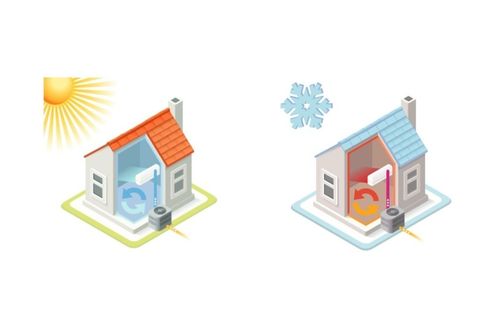Solar Energy
Solar Energy
Renewable energy, from the sun to our homes

All about aerothermal energy and its benefits
Solutions for heating and cooling our homes
One of the most important aspects for being able to enjoy our homes to the fullest is maintaining a comfortable temperature at all times, regardless of the season. However, cooling our homes in the summer or heating them when the temperatures start to drop can be quite costly, not just financially but on the environment, too. As a solution to this problem, aerothermal systems can represent one of the most sustainable, efficient, and affordable solutions for heating and cooling homes and buildings. But what exactly is aerothermal energy?


What is aerothermal energy?
Aerothermal energy, or an air source heat pump, is a system that provides cooling in the summer, heating in the winter, and domestic hot water (DHW) throughout the year. It works by extracting energy from the air through a system of electric heat pumps.
It uses a thermodynamic cycle that extracts heat from the outside air and introduces it into an indoor space, or extracts indoor air and transfers it outside when necessary. Aerothermal systems can extract up to 75% of energy from outside air, which significantly reduces electricity consumption in homes and buildings (in fact, half of electricity consumption in Europe is used for heating and cooling).
Aerothermal systems can sustainably and efficiently heat and cool spaces. Aerothermal generators are made up of an outdoor unit with a heat pump that extracts the heat from the air along with another indoor unit in the building that heats and stores water. This water is later used to heat and cool the space though radiators or underfloor heating, and it can also be used for domestic hot water.
How does aerothermal energy work?
The system works like this:

Advantages of aerothermal energy
Although it's true that installing an aerothermal system requires a greater initial investment, the savings it generates compared to other heating and cooling technologies allow you to amortize this in a short period of time.
Outstanding energy efficiency
There are systems that only require 1 kW of electricity to produce between 3 and 5 kW of heat, leading to a significant reduction on power bills in one of the areas that consumes the most energy — heating and cooling.
Extremely versatile
Apart from heating and cooling the home, the fact that this system also provides hot water maximizes its usefulness and makes it a more complete solution that can be used year round.
Air quality
As no combustion is required, no nitrogen oxide (NOx) or sulfur oxide (SOx) particles are emitted, which has a positive impact on air quality.
Silent
The indoor unit barely makes any sound.
Simple maintenance
The compressors have a very long life and can be easily replaced by technicians.
Safe
They don't require deposits for holding fuel, like conventional boilers, making them much safer.
Aerothermal energy with solar panels, an even more sustainable solution
On top of all the previously mentioned benefits, aerothermal energy is just lacking one component to become 100 % renewable: its combination with solar panels. By joining photovoltaic and aerothermal energy, the benefits of both are multiplied, both in terms of savings for your pocketbook as well as for the environment, as it implies self-consumption not just of electricity but also for heating and cooling and hot water.
Solar Energy
Renewable energy, from the sun to our homes

Types of solar panels
What types are there? Which one should you choose?